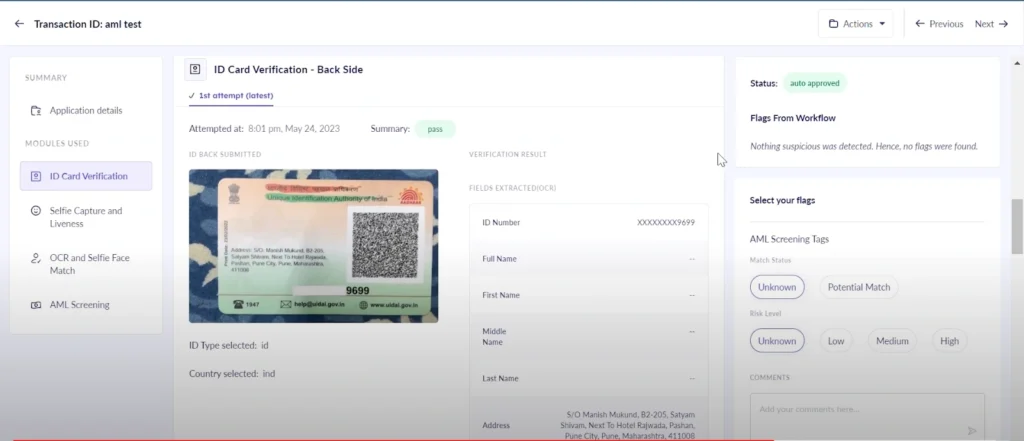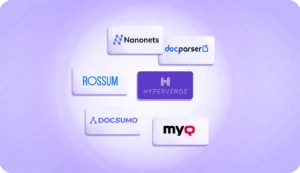If you work in the supply chain industry, you are aware of the kind of role logistics plays. It connects manufacturers, suppliers, and customers globally to maintain a balance between supply and demand. That’s why any form of inaccuracies, whether it’s from unclear scans, inconsistent logistics document processing or format, or manual data entry errors, can disrupt the supply chain operations with costly consequences.
This is where advanced Artificial Intelligence-powered Optical Character Recognition (AI OCR) technology comes to the rescue. It works as a powerful enabler by eliminating manual data entry, processing handwritten notes, and extracting information from low-quality documents.
Want to know more about AI OCR? In this blog, we explore AI OCR in logistics automation in detail.
How does AI OCR work in logistics workflows?
Once you know how AI OCR streamlines every step in logistics from document capture to system integration, you get the complete picture of its potential. Here’s how the process works in real-world supply chain environments:
1. Document ingestion and preprocessing
The process starts with scanning the documents, like bills of lading, shipping labels, invoices, packing slips, bank statements, and legal documents.
Before extracting any data, the system cleans up the images by enhancing them. It reduces smudges or any marks (think about ink blots left in invoices from leaky pens or dark streaks left by the old photocopier machine).
It also corrects or straightens any skewed pages by digitally rotating the image. This process lines up the text correctly, making it easier for the AI OCR technology to interpret the content.
Point to note: Advanced AI OCR tools can handle almost every type of document. It could be printed forms, handwritten notes, or even those low-quality scans that are hard to read. However, this only applies to tools that can process unstructured data.
2. Intelligent data extraction
After the document is prepped, the data extraction model, backed by AI and machine learning, kicks in.
Instead of just reading text line by line, these models understand the layout and context of each document. They can spot and extract key details such as tracking numbers, customer names, delivery addresses, Stock Keeping Units (SKUs), and carrier information in shipping documents.
It doesn’t matter what the document data format is, you get accurate, real-time data every time.
3. Logistics system integration
The extracted data doesn’t just sit in a file, it flows directly into your existing logistics platforms. Thanks to API-first architecture, this integration is smooth and enables real-time automation.
As soon as a document is scanned, the digitized data is routed to the right place instantly. This ensures that the next steps in the workflow, like dispatching goods, updating billing, and providing instant tracking updates to customers, work in tandem.
Read More: A Buyer’s Guide To Choosing The Best OCR Software
Traditional logistics workflows vs. AI-driven automation
Want to understand how AI systems work against traditional logistics systems? Here’s a dedicated section to help you clearly differentiate and understand the differences between the traditional OCR workflow and AI-driven OCR automation:
Traditional OCR workflow:
- Manual handling of documents: In traditional OCR systems, logistics operations rely on paper-based documents such as bills of lading, handwritten delivery notes, and printed invoices. These physical documents require manual collection, sorting, and processing, which slows down the entire supply chain operations.
- Human data entry: The process of entering data from these documents into the inventory management system is done manually by staff. This is naturally prone to human errors, such as typos or missed fields, that can lead to inaccurate records and operational inefficiencies.
- Limited visibility and delayed updates: Because data entry and document processing are manual and sequential, updates to logistics systems happen with delays. This is especially problematic in high-volume operations where timely information is critical for tracking shipments, managing inventory, and responding to issues promptly.
AI OCR automation:
- Documents are scanned and digitized at source: This is one of the key AI-powered OCR solution benefits. AI OCR processes documents to extract and digitize key information. This serves two big advantages: there is no need to carry physical documents throughout the process, and the data is instantly available for use.
- Key fields are extracted automatically in real-time: AI-powered OCR algorithms eliminate the need for manual data entry. It identifies and extracts relevant information such as shipment numbers, addresses, dates, and invoice details automatically and accurately.
- Data flows seamlessly into logistics systems (ERP, WMS, TMS): Extracted data is integrated directly into multiple systems like enterprise resource planning (ERP), warehouse management systems (WMS), and transportation management systems (TMS). They no longer have to sit down and manually vet the process as automation takes care of it.
Below is a quick table differentiating traditional logistic workflows from AI automation:
| Feature | Traditional logistics workflows | AI-driven automation |
| Pricing | Generally lower upfront costs, but higher long-term operational expenses due to manual labor | Higher initial investment, but reduced ongoing costs through automation |
| User interface | Familiar, manual processes with basic digital tools | Modern, intuitive dashboards with real-time data visualization |
| Customization | Limited flexibility; changes require manual intervention | Highly customizable and adaptable to changing business needs |
| Support | Standard business hours, often slower response times | 24/7 support with faster resolution via AI-powered systems |
| Integrations | Limited integration with other digital platforms | Seamless integration with a wide range of software and IoT devices |
Ready to leave manual errors behind?
Let HyperVerge’s AI OCR make your logistics workflow faster, smarter, and error-free. Schedule a DemoKey use cases of AI OCR in logistics automation
AI OCR contributes to different areas of daily logistics operations. From powering shipment tracking to seamless invoicing, it also takes care of faster customs clearance and smarter warehouse operations.
This section explores how AI OCR solves everyday logistics challenges and drives efficiency:
1. Shipment labeling and tracking
AI OCR streamlines the reading of barcodes, QR codes, and printed labels. This allows the logistics teams to digitize shipment data instantly as packages move through each checkpoint. This automation ensures real-time tracking updates and eliminates manual data entry errors, which are common in high-volume environments.
For example, when a package arrives at a warehouse or transfer point, AI OCR extracts tracking numbers and addresses from labels in seconds, updating systems immediately. This not only speeds up processing but also provides proper visibility for both logistics teams and customers, reducing the risk of misplaced or delayed shipments.
2. Invoice and proof-of-delivery automation
Manual processing of invoices and proof-of-delivery (POD) documents is slow and error-prone, often leading to payment delays and disputes. With AI accounting OCR, logistics companies can automatically extract relevant data from scanned invoices and PODs and feed it directly into accounts payable or delivery confirmation systems.
For instance, when a driver completes a delivery, a quick scan of the POD updates the system and triggers automated invoicing. This automation accelerates workflows and minimizes the risk of lost or misfiled documents
3. Customs and compliance documentation
Cross-border shipments require meticulous documentation-bills of lading, commercial invoices, certificates of origin, and more. AI OCR digitizes these documents, extracting and validating key data to ensure compliance with customs regulations.
For example, when customs paperwork arrives in various formats (email, fax, or paper), AI OCR reads and standardizes the information. This speeds up customs clearance, lowers operational costs, and helps avoid regulatory fines.
4. Warehouse operations
In busy warehouses, AI OCR automates the capture of data from inbound and outbound shipment documents, such as packing lists and inventory receipts. As goods arrive or depart, OCR instantly reads product labels and barcodes and updates the inventory records in real time. This reduces manual paperwork, minimizes stock discrepancies, and accelerates order fulfillment.
For example, during peak seasons, AI OCR enables warehouses to process thousands of items quickly and accurately. It also ensures that inventory levels are always up to date and reduces the risk of lost or misplaced goods.
Read More: How to Leverage Advanced OCR in Healthcare
Benefits of using AI OCR in logistics
Going digital is only a part of AI OCR in logistics. In a broader sense, it provides real, measurable benefits for your supply chain operations.
Faster processing and fewer errors are the main highlights. But what are the other benefits? Find out in this section.
- Faster document processing and reduced manual effort: AI OCR can cut the time to process logistics documents from several minutes to just a few seconds, freeing teams from repetitive tasks
- Fewer data entry errors: AI-powered OCR reduces errors related to manual data entry, ensuring higher data accuracy and minimizing costly mistakes
- Shorter turnaround times in shipping and delivery: Automated data capture and instant integration mean shipments move faster through each stage, reducing delivery delays and improving overall supply chain agility
- Cost reduction via automation: Companies adopting OCR automation to automate data entry report an average operational cost reduction of 32%, thanks to less manual work and fewer errors. Businesses also save an average of 20 hours per week of manual labor by automating data extraction
- Improved customer experience through real-time updates: Real-time data flow enables instant tracking updates and faster response to customer queries, leading to higher satisfaction and loyalty
Challenges and considerations
While AI OCR brings powerful advantages to logistics, it’s important to recognize the challenges that can come with implementation, like:
- Variability in document quality: Logistics documents often arrive with smudges, faded text, or handwritten notes. Even the best AI systems can struggle to interpret damaged or low-quality scans, which may impact data accuracy
- Integration complexity with legacy systems: Many logistics companies still rely on older software and hardware. Integrating AI OCR with these legacy systems can be complex and may require custom solutions or additional resources
- Language and template diversity: Logistics operations span multiple countries and partners, leading to documents in different languages, formats, and layouts. While AI OCR is more adaptable than traditional OCR, handling rare languages or unusual templates can still be challenging
- Data security and compliance concerns: Extracting and digitizing sensitive information raises concerns about data privacy, unauthorized access, and regulatory compliance. Ensuring secure handling and storage of extracted data is essential for building trust and meeting legal requirements
Don’t let document hurdles slow you down.
Check out HyperVerge OCR, built for the toughest logistics documentation challenges. Schedule a DemoFuture of AI OCR in logistics automation
As logistics continues to digitize, understanding the future of AI OCR helps businesses stay ahead of the curve. Let’s take a look at the trends and technologies shaping the next era of logistics automation.
- Role of deep learning and transformer-based models: AI OCR is evolving rapidly thanks to deep learning and transformer architectures. These advanced models excel at recognizing complex layouts, mixed handwriting, and printed text. This means even greater accuracy and adaptability for document processing.
- Autonomous logistics workflows (pairing with RPA, IDP): The future is about seamless automation. By combining AI OCR with Robotic Process Automation (RPA) and Intelligent Document Processing (IDP), logistics companies can achieve end-to-end automation-from document capture to data entry. There will also be workflow triggers, which will reduce manual intervention and speed up operations
- Real-time analytics from extracted data: With smarter OCR, logistics teams can instantly analyze extracted data for trends, bottlenecks, and performance metrics. This enables proactive decision-making and continuous improvement in supply chain management
- Industry trend of moving from OCR to Intelligent Document Processing (IDP): The industry is shifting from basic text recognition to IDP, which combines OCR, machine learning, and natural language processing. IDP understands context, validates data, and integrates with business systems, which unlocks new levels of automation and insight.
Conclusion
AI OCR is truly a game-changer for modern logistics, making operations faster, more accurate, and nearly error-free.
Automating data extraction from even the most complex documents is helping logistics teams cut manual effort, reduce costly mistakes, and deliver a smoother customer experience.
If you’re looking to bring these benefits to your logistics operations, HyperVerge’s AI-powered OCR software stands out with 90 %+ accuracy, multilingual support for over 150 languages, and seamless integration with your existing systems.

The platform can handle both structured and unstructured documents-like bills of lading, invoices, and delivery notes-so you can process any paperwork, anywhere, with confidence.
Does HyperVerge sound interesting? Sign up for a demo and find out if it meets your expectations
FAQs
1. How is AI OCR different from traditional OCR in logistics?
AI OCR goes beyond traditional OCR by using machine learning to understand context, adapt to different document layouts, and identify patterns in logistics.
While traditional OCR relies on fixed templates and often struggles with non-standard or low-quality documents, AI OCR learns from data, improves over time, and can extract key fields (like tracking numbers or addresses) with much higher accuracy and flexibility.
2. What documents can AI OCR automate in the supply chain?
AI OCR can automate data extraction from a wide range of logistics documents, including bills of lading, shipping labels, invoices, customs forms, packing slips, delivery receipts, proof of delivery, and warehouse receiving documents. It can also process return labels, purchase orders, and even handwritten notes.
3. Is AI OCR accurate enough for compliance-heavy logistics workflows?
Yes, modern AI OCR solutions are highly accurate, often achieving 95% to 99.5% accuracy in extracting and classifying data from logistics documents, even in complex or compliance-heavy scenarios. They use advanced validation, cross-checking with databases, and continuous learning to minimize errors and ensure regulatory compliance.





